It all began with Cuba in 1959. That was a line in the sand for Tio Sam. Kennedy launched the Alliance for Progress in ‘61, and caudillos throughout South and Central America lined up for lessons on how to prevent their own homegrown communists from reproducing what Fidel and El Che had brought down from the Sierra Maestras. The School of the Americas’ manual of torture, originally drafted in Scotland and likely passed along during WWII to eager Yanks in the OSS, was in due course thumped like the bible into the hands of willing thugs in the pay of ruling elites from Guatemala to Chile. In Brazil, when the military grabbed the reins of government on April 1, 1964, the torture manual came off the shelf for immediate application to those who were obnoxious to the dictatorship ideologically, and with lethal consequences for some who fought from the more militant wings of the resistance.
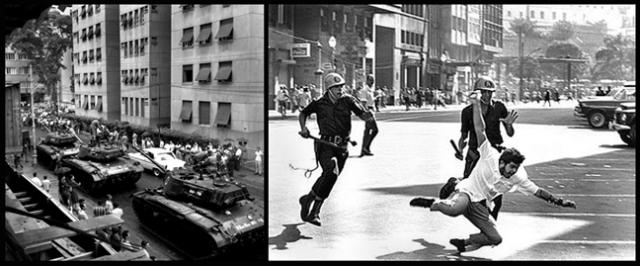 Images from the 1964 coup; the man on the run was used to illustrate posters for a recent panel discussion
Images from the 1964 coup; the man on the run was used to illustrate posters for a recent panel discussion
I was in Brazil at the time of the 1964 coup, spending a year at Rio’s exclusive Catholic University (PUC). I spent considerable time at first with a guy named Bud who worked for USIA, the “public” face of American overseas diplomacy. The agency operated cultural programs and libraries, also, back in D.C., Voice of America, where I worked part time as a Georgetown undergrad. My friend was a good guy, a kind of mentor twenty years my senior who welcomed me into his family as I slowly acclimated to the seductive lifestyle of the Brazilian gentry on the coattails of their sons and daughters, my classmates, who would invite me home for the hot sit-down midday meal, cooked and served by the black live-in empregadas. An American student was a novelty in those days, and, being short of funds, I was happy to eat out on it.
After a month I met Chris, an American my own age who’d been ski bumming in the Alps and drifted to Brazil to look up an uncle who held the second highest rank in the U.S. Embassy. Chris had just received his draft notice from home, and we got it in our heads to hitchhike to the Amazon where he’d hideout and avoid military service now that Vietnam was coming on with a vengeance. I don’t recall if we clued Bud in about the exact reason for our abrupt departure from Rio, but he very kindly provided contact info for other U.S. diplomats we could crash with as we made our way north along the coast. Our first stop was in Vitoria, a small coastal port for shipping ore from the neighboring but landlocked mineral rich state of Minas Gerais. The diplomat we stayed with in Vitoria, Bud had explained, was setting up a co-op to rival a similar effort influenced by the local communists who, by that time in Brazil, were organized into a mélange of currents on all sides of the Sino-Soviet split.
This guy in Vitoria, absent the charisma, was cut to the Dr. Tom Dooley mold, one of the hordes of Cold War zealots the U.S. had posted for mischief in the guise of good works throughout the backwaters of the non-communist world. On paper, of course, the Alliance was a blue print for bloody utopia. Here’s the Wiki version of what it claimed to have stood for: “an annual increase of 2.5 percent in per capita income, the establishment of democratic governments, the elimination of adult illiteracy by 1970, price stability, to avoid inflation or deflation, more equitable income distribution, land reform, and economic and social planning.” It read well in Nebraska, but it was not the masses, but the Brazilian burguesia and latifundists who were the real U.S. clients, and they were hardly down for a program that altered the social balance. If people could read, they could vote. What might that lead to?
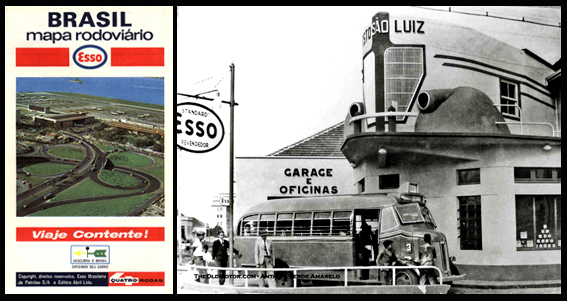 Esso and Standard Oil were big players in Brazil in the mid-1960s
Esso and Standard Oil were big players in Brazil in the mid-1960s
Chris developed cold feet by the time we reached Bahia, and his uncle got the Brazilian Air Force to fly us back to Rio on an old DC-3. I went back to the university, and Chris faded from view. As for my Rio-based mentor, he was nothing like this Vitoria guy. Bud was a free spirit, so was Chris and I was drawn to both of them. Before I eventually went Brazilian myself, committed to learning the Portuguese that continues to serve me to this day, and cut off contact with the American community, I would join Bud many afternoons into evening in a café on the Leme end of Copacabana Beach, quaffing drafts of Brahma, Brazil’s principal lager, until the call came from his loving and indulgent wife reminding him about dinner. In his own way, Bud too seemed to have gone native, and, whatever his real job, it didn’t press heavily on his leisure. I don’t remember what we talked about, but, other than that offhand remark he’d made about jousting with commies in Vitoria, it was never politics, an interest at twenty I was late to come to.
The coup in 1964 that toppled the democratically-elected president, Joao Goulart, took place on what, here in the States, we might have thought of as a distinctly unfunny April Fool’s Day. I barely took notice, other than to feel a certain awe at being witness to tanks and soldiers in the streets, a dissociated scene that some TV news commentator back home might have disparagingly deconstructed as just one more “revolution” in a Banana Republic. This was the way it was supposed to be down here, perennial instability, a succession of golpes and juntas, one strong man taking the place of another. That I’m sure would have been the thought implanted in my head when I first arrived. Not that Americans were ever taught to give a shit about anything real happening south of the border, least of all about the U.S. role in choreographing so much of the chaos.
Ironically it was the USIA operative in Vitoria who got me free passage home at the end of the year on an ore boat, a program the State Department had set up with shipping companies to lure young Brazilian leaders to Washington and prep them as future partners friendly to U.S. interests. It was 1984 before I returned, and Brazil was in transition back to its own brand of democracy. I went back frequently after that as a travel writer until the late nineties. Following another long absence I felt somehow an appointment with destiny to be back in Rio on that commemorative day in 2014.
This was a personal milestone, five decades since my college year at PUC, and, of considerably more historical importance, the 50th anniversary of the coup that had ushered in what Brazilians label os anos de chumbo, the years of lead that blanketed their freedoms over the better part of a quarter century. That long night of State terror and repression had by now become softened by a succession of democratic governments, not to mention structural reforms that actually give content to the vision the Alliance for Progress had once falsely promised. I wanted to be there to experience first hand how contemporary Brazil would remember its leaden past, officially or otherwise.
I bracketed the time surrounding March 31 and April 1, the key dates of the ‘64 coup. I would arrive in Rio two weeks in advance of those dates to gauge the build-up toward the commemoration or “de-commemoration” – as it was being styled by the Left – and stay a week afterwards to record the post-mortems. I quickly discovered that interest in the commemoration/de-commemoration narrative was primarily institutional: the state and federal truth commissions, and the Left intelligentsia operating from a secure academic base, held the major franchises. To the extent the topic was taken up in public forum, this task fell to the print media, and perhaps television to a much more limited degree. I did not monitor the TV news. But I suspect that the an otherwise disinterested povao – the bulk of Brazil’s population – for form’s sake if nothing else was fed a few choice sound bites on the nightly telly referencing a past far too remote for most of them to relate to in the here and now.
The newspapers, on the other hand, offered a rich historical accounting to their more sophisticated readership. Every day I was there leading to April 1st, Brazil’s two mass circulation dailies, O Globo and Folha de Sao Paulo, devoted pages of ink to the topic. Editorials in both papers temporized in pseudo apologetic language, copping, sort of, to their owners’ unambiguous jubilation about Jango’s fall in ‘64 and their full-throated collaboration with the golopistas. Op-eds abounded, even a few that defended certain mythic advances attributed to the dictatorship. There was an intriguing article on direct action by social movement groups to track down and confront the torturers still living among them. And more than a few personal accounts were written by surviving relatives of those who had been murdered by the generals’ goons, their remains disappeared. Typically these folks demanded that the armed forces open the relevant archives and reveal the paper trail that led to and documented the grim outcomes the familiars of the victims have been long aware of. It is taken for granted that in the Brazilian military mind records of the darkest secrets are sacramental, and cannot be destroyed, because, goddamnit, we were right to cut off his fingers, pull his teeth and dump that subversive sob in the river, and someday they’ll thank us for it. It appears that, minimally, victims’ relatives wish to see the military institution publicly humiliated, and the perpetrators still alive who ordered or carried out the murderous crimes brought to justice and punished.
It is my intention here to process the thoughts, notes and materials I came home with into a series of reports on the commemoration/de-commemoration rituals I went to Rio to observe, this being the first installment. I had initially reasoned that the attention given to the 50th anniversary in Rio would be more intense and varied than anywhere in Brazil, except perhaps Sao Paulo; and who would go to Sao Paulo if you could spend three weeks in Rio, which, in any case, was where the coup had been staged? To understand how the Brazilian armed forces and their allies throughout civil society came to engineer that coup brings me back to where I began about the threat represented by Cuba, and to pose the most critical question of all: Was Brazil in the early 1960s in danger of “going communist?”
In fact the principal struggle in Brazil in those years was not between the communists and their capitalist foes, but was internal to the elite classes, twenty percent of the population, led by the greediest of the greedy. At the time 70 percent of the population was illiterate, if not in vagabondage then employed in menial jobs in the cities or scraping out subsistence on rented land in the countryside. To pick a figure out of a hat, actually one I was given by a law professor attached to Rio’s Truth Commission, the Communist Party had about 80,000 members at the time of the coup. This figure is probably a composite of all the factions, the dominant pro-Soviet party and the substantial split-off of those who sided with Mao and the Chinese, while not forgetting the usual farrago of Trotskyist dissenters.
The hay day of the Brazilian communist movement, like in the U.S., had been in the years prior to World War II. Under Cold War pressures from the North, the Brazilian government – and not for the first time – declared the party illegal. After that, communist militants continued to operate cautiously among the more advanced sectors of the working class, like urban bank clerks and also within the rising industrial sector outside Sao Paulo. Its leaders in the meantime went underground. Communists were arrested, tortured and killed in this period, I was told. By the time of the coup, the Soviet affiliated party, the Big Party the Brazilians call it, was much depleted in membership and did not have a plan to govern, or an armed struggle strategy to take power through insurrection. It was, as one knowledgeable historian described it to me, essentially pacifist, certainly unarmed.
In a nutshell, the real contest over who would govern in Brazil pitted opposing sectors within the traditional political classes who distributed power among themselves through fluid coalitions that depended on greasing palms and horse trading. Joao Goulart, known as Jango, the president who would be toppled in ‘64, was leader of the forces that had once coalesced around Getulio Vargas, Brazil’s dictator from 1930 to 1945. Vargas had flirted with the Axis until FDR funded a steel mill at Volta Redonda in exchange for the use of airfields in Natal that gave the U.S. a logistical trampoline to support the early war on the coast of North Africa, and brought Brazil into the Allied orbit.
Jango served as Minister of Labor when Vargas was democratically elected president after the war. Vargas had created the Brazilian Labor Party (PTB), and set protectionist parameters that sustained state monopolies in the oil, steel, automotive and mineral extraction sectors, undoubtedly improving the lot of some working Brazilians. The PTB and its populist tendencies, inherited by Jango, was unpopular with the military who saw an even watered-down Keynesian social democracy as a gateway to communism, and in 1956 they tried unsuccessfully to block Jango’s nomination as VP on the ticket headed by Juscelino Kubitschek – the father of Brasilia.
When Jango ran again in 1960, this time for the presidency, opposing Janio Quadros, who would beat him, he was nonetheless reelected a second time as vice president since Brazilian voters were allowed to split their ticket among candidates of competing parties. When Quadros suddenly resigned in August 1961, Goulart was on a state visit to China. A strong opposition arose to prevent his succession, but after biding his time for several days in Montevideo, before crossing back into Brazil, Jango was installed as president, initially with reduced powers.
Jango was no radical, but, like Vargas and Janio Quadros, he favored a plan of national development based on a foreign policy of non-alignment and wanted to make it harder for foreign businesses to transfer their profits out of the country, favoring their reinvestment in Brazil. It should be noted that it was Janio Quadros — not Joao Goulart — who established relations with the Soviets, and, a year before in Brasilia to the utter horror and consternation of the Brazilian right and their military allies, pinned a decoration on the chest of Ernesto Guevara. There were many in the Brazilian ruling class who resented American bullying and domination.
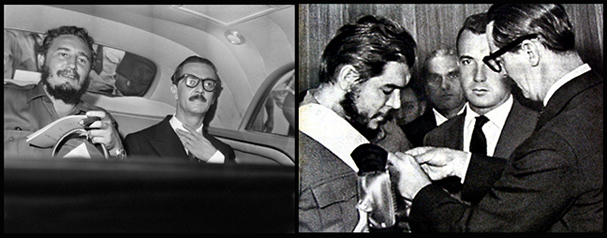 President Janio Quadros with Fidel Castro in Cuba in 1960, and giving Che Guevara a medal in 1961
President Janio Quadros with Fidel Castro in Cuba in 1960, and giving Che Guevara a medal in 1961
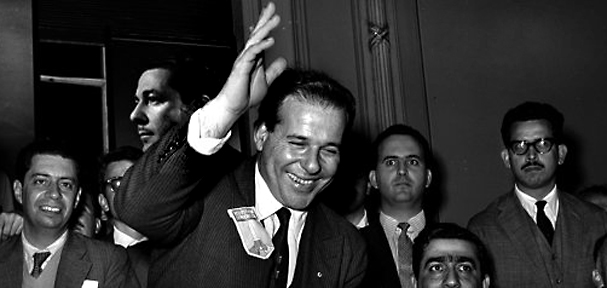 In 1961, Vice President Joao "Jango" Goulart accepts the presidency after Janio Quadros resigns
In 1961, Vice President Joao "Jango" Goulart accepts the presidency after Janio Quadros resigns
To help build popular support for his “grassroots reforms,” which also included a modest land reform proposal and an educational program that would seriously attack illiteracy on the model created by the legendary theorist Paulo Freire, Jango called for a mass rally in downtown Rio on March 13, 1964, attended by tens of thousands. His hard right opponents trumped his demonstration several days later in Sao Paulo with an even more massive demonstration, the March of Families for God and Freedom, a formula which made no attempt to hide its fascistic sneer.
But the contest was never between the Marxist Left and the Right. It was between a centrist reformer who had a vision of gradually developing a Brazilian capitalist economy where the policies he encouraged would, among other objectives, build a stronger internal market, and the internationalists who would happily sell their country’s labor and resource to the highest bidder, so long as their own profits were high and nothing was done to endanger their spectacular privileges. Jango wanted to turn more Brazilians into consumers. Under the Pax Americana, this was not an option, though, as rebellion, it was clearly leagues from Jango’s alleged communist conspiracy. After World War II, capitalism went international, and the game afoot saw the economic shots for the third, or “developing” world, being called by Wall Street and in Washington, delegating the tasks of policing development to new financial global overseers like the World Bank and the International Monetary Fund.
Much is therefore made of the U.S. involvement in the ‘64 Brazilian coup. Trust me, Brother Sam, as the covert operation in waiting was termed, was there to help if needed and called upon. This proved not to be necessary. The foundation of the coup assembled with ample guidance and funding from friendly sources had been firmly set in place over the previous few years. That Tom Dooley character in Vitoria? He was strictly a cover operation. The real show involved “integrating the various social movements of the right to create bases of operation that could prevent the spread of Soviet-style communism in the West.” This was not a task assigned to the peasants.
Preparations for the coup were carried out through newly established instruments like IPES, Instituto de Pesquisas e Estudos Sociais – call it the Social Research Institute – and IBAD, Instituto Brasileira de Acao Democratica – The Brazilian Institute for Democratic Action. These entities were created to coordinate action from the right against Goulart and his allies. It’s not hard to believe, as is widely alleged today in Brazil, that the generous war chest of several million dollars these groups possessed – big bucks in those days – somehow bore the fingerprints of U.S. agents and businessmen. I myself was much surprised to learn from my contact on the Rio Truth Commission that it was the conservative elites, and not the communist Left, who had stockpiled the arms they calculated would be needed if the attempt against Goulart led to a civil war.
The night of the coup, Goulart found it difficult to find a jet to carry him safely south to his native state of Rio Grande do Sul. He ended up on a small two engine plane. Watching the dust settle in Rio and the rapid consolidation of power by the armed forces, utterly unopposed and indeed welcomed with all but universal acclaim across the establishment political spectrum, the Congress and the courts, in essence everyone who partook of the country’s sanctioned political life, Jango slipped quietly into Uruguay, later Argentina, and the exile from which he would never return. It has long been rumored that Jango was assassinated in late 1976 by means of poison. At the end of this month, April 2014, an analysis of his exhumed remains will be made public, and the plot long alleged will be confirmed or dismissed, or just as likely, left hanging in the air.
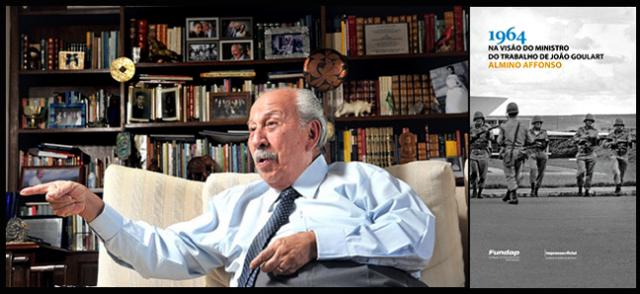 Almino Affonso, minister of labor under President Goulart, today, with the cover of his book on the coup
Almino Affonso, minister of labor under President Goulart, today, with the cover of his book on the coup
In the stream of newspaper retrospectives about the coup, there was an interview with Almino Affonso, Minister of Labor under Jango. Affonso begins by posing a rhetorical question. Was his boss, Jango, really in the process of preparing a communist coup as his adversaries were loudly proclaiming? Affonso then ticks off the names of ministers in Jango’s cabinet, adding something of each man’s political and social pedigree. Which of them, he wonders aloud, could be said to have had the profile of a communist conspirator? You can almost sense former Minister Affonso shaking his head in existential disbelief as he delivers his punch line: “The falsification is truly breathtaking.” At the time of the coup, public opinion favored Jango’s proposed reforms by a whopping 72 percent. But this was not a mass base that could be mobilized to save him.
Michael Uhl is a Vietnam veteran who worked in intelligence; he is author of the memoir Vietnam Awakening: My Journey from Combat to the Citizens’ Commission of Inquiry on U.S. War Crimes in Vietnam. He’s currently working on a second memoir. He speaks fluent Portuguese and has written travel guides on Brazil. He lives in Maine.
